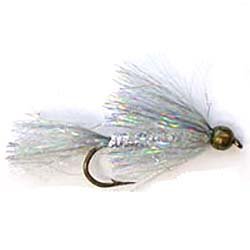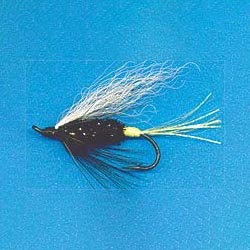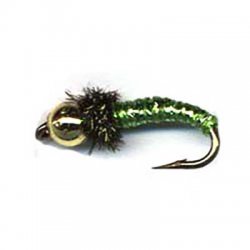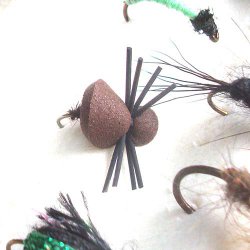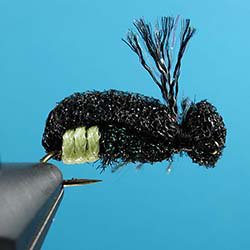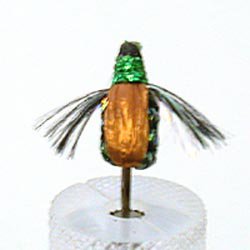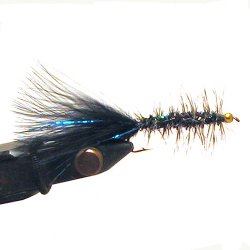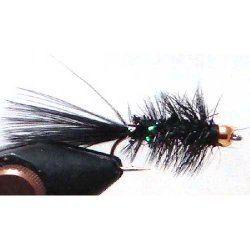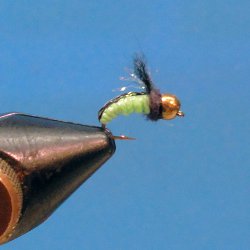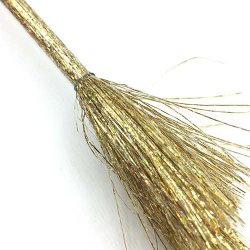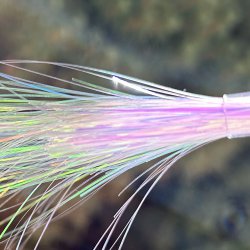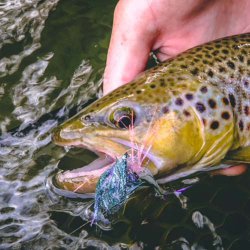- Shop Fly Fishing
-
Shop Needlework
- Metallic Threads
- Silk Threads
- Kits & Sets
- Accessories
- Free Patterns
- How To
22 products found
Sort by:
Recommended
Shop Fly Fishing > Free Patterns
-
Long Bridge Sally Pattern
This product is not shipped
Long Bridge Sally
Designed By Dave Schmezer
Materials Needed:
- Hook: Mustad 79580 or 9672 : #6 - #12
- Thread: 6/0 - Color to match
- Head: Brass bead head of appropriate size
- Tail: Clump of marabou with about 10 strands of Kreinik Metallic Flash In A Tube™ in a color to match the 1/6" Ribbon listed next
- Body: Kreinik 1/16" Ribbon color suggestions: Chartreuse 015, Black 005, Star Yellow 091, Glow In The Dark Green 053F, Peacock 085 — or your choice of colors
- Kreinik Flash In A Tube in colors similar to 1/6" Ribbon — or your choice of colors
- Collar: 3-4 turns of folded saddle hackle or spey hackle on larger flies
Tying Directions:
- Install bead head.
- Begin tying thread behind the bead head, wrap thread base rearward until several turns before bend of hook, then return thread forward.
- Tie in marabou on top of hook shank, leaving gap between the bead and marabou. Marabou Marabou should extend 1-1/2 hook gaps past bend. Be sure to trim the marabou short of the bead head. You will need room wind the hackle later.
- Tightly wrap thread to rear just before the bend, then return forward.
- Tie in 8 to 10 strands of Kreinik Metallic Flash In A Tube™ on each side. Wrap thread to rear just before the bend, then return forward.
- Tie in Kreinik 1/16" Ribbon on top (still leaving a gap for the hackle). Wrap thread to rear just short of bend then, return return forward.
- Wrap Ribbon forward and tie off just behind the bead. Add a drop of head cement to lock the ribbon in, trim excess.
- Tie folded saddle hackle in by the tip, behind the bead head, with five or so tight wraps.
- Take three-four turns of hackle, stroking the hackle back as you wrap. Tie off, secure with several whip finishes and apply head cement to wraps.
Editor's Note: Dave says that you can tie this fly in different colors and sizes to catch just about anything that swims. I agree with Dave. I have tied this pattern in Kreinik Glow In The Dark Yellow color (#054F) to catch Hickory Shad, and in Purple (#026) to catch Smallmouth Bass.
-
Green Butt Skunk Pattern
This item is not shipped
Green Butt Skunk
Modified by Ray Larsen
Materials Needed:
- Hook: Salmon #2 - #8
- Thread: 6/0 - Black
- Wing: White Calf Tail
- Tail: 10 strands of Kreinik Flash In A Tube™ in (#054F) Glow In The Dark Yellow, or (053F) Glow In The Dark Green
- Butt: 1 strand of Kreinik Flash In A Tube™ in (#054F) Glow In The Dark Yellow, or (053F) Glow In The Dark Green
- Body: Kreinik Micro Ice Chenille - (#005) Black
- Throat: 3-4 turns of folded black saddle hackle
Tying Directions:
- Start at the tail. Tie in about 10 strands of Kreinik flash so that they extend about 1" past the bend of the hook.
- After tying off the tail material, wrap over the tailing material with the single strand of Kreinik flash to form the butt. After about 7 or 8 wraps, tie off flash.
- Wrap you thread forward to a point about 1/4" from the eye of the hook. To form the body of the fly tie in the Micro Ice Chenille and wrap the chenille rearward, and then wrap back forward and tie off at the same point where you tied it in.
- To form the throat hackle, tie in a saddle hackle, and make two wraps.
- To form the wing, tie in a clump of calf tail on top of the hook at the same point as the Micro Ice Chenille so that the calf tail extends about 1/2" past the bend of the hook.
- To finish, tie off the calf tail, and build up a neat head with your tying thread, and coat with head cement.
- Editor's Notes: Ray Larson is a guide from Sheboygan, Wisconsin. Most green butt skunk patterns have a silver tinsel rib, but Ray says that the black Micro Ice Chenille is so shiny, the ribbing is not necessary.
-
Caddisfly Pupae Pattern
This item is not shipped
Caddisfly Pupae
Designed by Al Hafner
Materials Needed:
- Hook: #12 - 16 Tiemco 2487, Mustad 3906
- Thread: 6/0 Black
- Body: Kreinik Fine or Medium Braid in Chartreuse (015)
- Head: 1/8 inch brass bead
- Collar: Peacock Herl
Tying Directions:
- Pinch barb down and slide bead on to eye. The bead adds weight and make the fly drop head first into the water. If using this fly without a bead head, fish with a sink tip line and a short leader.
- Tie on the body material. If your using Medium Braid: tie in at bend of hook, wrap to head and tie off. If you're using Fine Braid: tie in at head, wrap to bend and return to head, then tie off.
- If desired, a collar can be tied in between the bead head and the body braid, using one strand of peacock herl. Tie off and add head cement. This collar is needed if a bead head is not used. Emergent Pupa Version: Do not use a bead head. Add a marabou or hackle collar to simulate wings and legs. Add a small peacock herl collar. Other body colors often used for this pattern are: Red (003), Emerald (009HL), Copper (021), Brookie (034), Bronze (052HL), and Mallard (850).
-
Disco Beetle Pattern
This item is not shipped
Disco Beetle
Designed by Harrison Steeves, IIIMaterials Needed:
- Hook: Tiemco 2487, #8-12. This model hook works better than a standard wide gape dry fly hook for this pattern. The curvature of the hook allows plenty of room between the body and the hook point.
- Thread: 6/0, color of choice
- Body: Foam Tying Disc 1/2" in color of choice
- Foam Tying Disc 1/4" in color of choice
- Underbody: Kreinik Medium #16 Braid in color to match 1/2" Disc
- Legs: Use either fine or medium round rubber leg material in colors to either match or contrast with the body color, or use Kreinik 1/8" Ribbon in (#850) Mallard to form wings.
Tying Directions:
1.) Wrap the hook shank with thread back to a point just behind the eye of the hook. Tie in a piece of Kreinik Medium Braid. Wrap the braid to a point even with the bend of the hook, and then wrap forward to where you tied the braid in. Tie off, cut excess.
2.) Place 1/2" foam disc on top of the hook shank with the front of the disc extending just over the eye of the hook. About one quarter of the disc should be extending forward from the point at which the tying thread is positioned on the hook shank. The forward extending portion of the foam will thus form the head of the beetle. The remainder extending toward the rear, will form the body of the beetle.
3.) Fold the foam disc evenly over the hook shank and tie it down. At this point you should have a good head and body formed. Give it another ten or twelve tight wraps of thread so the body will not turn on the hook shank.
4.) Tie in the 1/4" disc at the same spot as the 1/2" disc. This disc serves as your ez viz indicator. A small amount of super glue can be applied to the underside of the finished fly if your fly bodies turn, but tight thread wraps are usually all that is necessary.
5.) Legs or wings can be tied in on the sides of the body and trimmed to appropriate length. I usually tie this beetle with wings no longer or just slightly longer than the body of the beetle. Once the legs or wings are tied in, whip finish and remove thread.Editor's
-
Steeves’ Firefly Pattern
This item is not shipped
Steeves FireflyDesigned by Harrison Steeves
Materials Needed:- Hook: #12, 14,16: Tiemco 5212, Orvis 1638, Mustad 94831
- Thread: 6/0 Black or Orange
- Wing Case: Kreinik 1/8” Ribbon Black Hi Lustre #005HL
- Body: Orvis 1/8” thick closed cell black foam, cut into 1/8” wide strips
- Underbody: 3-4 strands of peacock herl
- Butt: Kreinik Medium #16 Braid Glow in the Dark Lemon-Lime (Yellow) #054F
- Wing: Either 1/8” Kreinik Ribbon or Kreinik Heavy #32 Braid in Mallard #850 or 085
Tying Directions:
1. Wrap first half of hook shank with thread. Tie in wing case material (use about a 6 inch piece) to the bend of the hook (end of shank).
2. Wrap thread forward 2/3 length of hook shank, tie in foam strip and wrap backward to bend of hook, even with wing case material.
3. Tie in butt material (about a 6” piece) and wrap thread forward enough to allow two to four wraps of butt material forward (two on the smallest hook, and four or more on larger fireflies). Wrap butt material forward(3 wraps on a #14 hook), and tie down on top. Trim off excess butt material.
4. Tie in 3-4 strands of peacock herl in front of butt and wrap thread forward to within about 1/8” of hook eye. Wrap peacock herl forward and tie down. Trim off excess herl. Wrap thread back and then forward through herl for reinforcement.
5. Fold foam over and forward to form body, tie it down about 1/8”back from the eye of hook and trim to leave a head extending to or slightly over the hook eye. Save excess foam for more bodies.
6. Tie in winging material at the point where the head and body join. Wings should extend back no further than the butt. Trim forward portion even with front of head.
7. Separate winging material evenly on both sides of the body, fold wing case material forward and tie down. Trim wing case material even with front of head and save excess for more flies. Whip finish.
Note: You can substitute brighter colors of 1/8” Ribbon for the wing case such as 051F, 052F, 053F, 054F or 055F. These colors will make the fly easier to see in the water.
-
Sinking Japanese Beetle Pattern
This item is not shipped
Sinking Japanese Beetle
Designed by Harrison Steeves, III
Materials Needed:
- Hook: #10 - Tiemco 3769, Orvis 1641, Mustad 3906
- Thread: 6/0 Olive or Green
- Body: Kreinik Heavy Braid in Mallard #850, Emerald #009HL
- Wing Case: Copper colored Swiss Straw or rafia
- Wing: Kreinik 1/8” Ribbon Mallard #850
- Head/Thorax: Kreinik Fine Braid Chartreuse #015
Tying Directions:
1. Wrap the rear half hook shank with thread.
2. Tie in Swiss Straw, use about a 4” piece. Tie in the Swiss Straw at the end of the hook, almost to the bend of the hook. Wrap thread forward to the middle of the hook shank.
3. Tie in two 9-10” strands of Kreinik Heavy Braid on each side of the hook shank. Tie them down by wrapping the thread backward to the same point at which the Swiss Straw exits the wraps. Wrap thread forward to about 1/16” behind the hook eye, half hitch (or whip finish) and cut thread.
4. Form the body of the beetle by using the overhand knot technique, passing the eye of the through the middle of the knot. Tie so that the 009HL strand form the back (top), and the 085 strands forms the belly (bottom). Use seven (7) knots to form the body on #10 hook. This will assure the proportions. When the body has been formed, tie down both body strands of material and cut. Note: When forming the knots, use PLENTY OF TENSION. If you don’t, the body looks really loose, and there won’t be enough room at the front of the hook to finish the fly.
5. Tie in the wing material, length extending back to the butt of the fly. Tie it in at the point where the body material cords were tied down and then wrap thread firmly toward, but not to the eye of the hook. Cut off the winging material piece extending forward and save for more wings. (use about a 6” piece - it’s easy tie in the correct length and then trim the forward portion. A 6 “ piece will tie a bunch of wings.)
6. Separate wing material into 2 equal halves and pull these laterally to the sides of the fly. I use a fine pair of tweezers for this, but a needle does fine.
7. Tie in about a 6” piece of Head/Thorax material - tie it in backwards to wing butts and on the side of the fly.
8. Fold Swiss Straw forward between wings to keep them separate, and tie down the Swiss Straw firmly from the wing butts almost to the hook eye. Trim to leave a small shelf of material pointing forward. Save the remainder of the Swiss Straw for more wing cases.
9. Wrap head/thorax material forward, 3-5 wraps depending upon how much space you have. After the last wrap, pull the material under the hook shank, tight into the eye of the hook and give it a couple of good thread wraps. Do not cut it.
10. At this point there is going to be some Swiss Straw visible, so tho finish the head neatly, first cock the fly at about a 45 degree angle in the vise. Bring the head/thorax material backward with the left hand and start building up the head with 6 wraps of thread. This will not only secure the head/ thorax material, but will give a neat head on the fly.
-
Sparse Woolly Bugger Pattern
This item is not shipped
This fly is purposely tied sparse. You can bet a trout has seen a lot of Woolly Buggers in their day and this pattern gives ‘em something to think about.
Materials Needed and Instructions:- 6/0 thread - Black
- 3x streamer hook
- Gold Bead 1/8 - 5/32
- Black marabou
- Kreinik Heavy #32 Braid in your color choice
- Kreinik Flash In A Tube 006HL – Blue Hi Lustre, or your color choice
- Grizzly saddle hackle
1.) Place the bead on your hook. You may need to crimp down the barb of the hook. Tie on your thread and wrap all the way to the curve of the hook.
2.) Measure a piece of Marabou about the same length as the shaft of the hook. Use a pinch wrap to tie on the marabou. This forms the tail. Trim off the excess. Tie in 4-8 strands of the Kreinik Flash In A Tube around the tail, and trim them to the same size as the tail.
3.) Tie the Kreinik Heavy #32 Braid & a saddle hackle feather at the tail. Tightly wrap the braid (not the hackle) forward to a point just behind the hook eye. Tie off the braid, and trim the excess.
4.) Wrap the hackle forward, and secure it at the head. Trim the excess, and add a whip finish to the fly.
Fishing These Flies:
The great thing about Woolly Buggers is that there is no wrong way to fish this fly. Add some weight to the fly or use a sink tip line to get you fly down deep and dead drift it. Use the same technique and strip it. Add even more weight to your tippet and bounce it along the bottom. Try an un-weighted version to fish along the surface and strip the fly in. This fly simply produces whether you are fishing the smallest mountain stream, large impoundments even in saltwater. -
Micro Ice Woolly Bugger Pattern
This item is not shipped
Replace peacock herl with Kreinik Micro Ice Chenille. Our peacock color is known as Peacock Herl on steroids.
Materials Needed & Instructions:- 6/0 thread - Black
- 3x streamer hook
- Gold Bead 1/8 - 5/32
- Black marabou
- Kreinik Micro Ice Chenille (Peackock or any other color)
- Kreinik Flash In A Tube 006HL – Blue Hi Lustre
- Grizzly saddle hackle
1.) Place the bead on your hook. You may need to crimp down the barb of the hook. Tie on your thread and wrap all the way to the curve of the hook.
2.) Measure a piece of Marabou about the same length as the shaft of the hook. Use a pinch wrap to tie on the marabou. This forms the tail. Trim off the excess. Tie in 4-8 strands of the Kreinik Flash In A Tube around the tail, and trim them to the same size as the tail.
3.) Tie the Kreinik Micro Ice Chenille & a saddle hackle feather at the tail. Tightly wrap the chenille (not the hackle) forward to a point just behind the hook eye. Tie off the braid, and trim the excess.
4.) Wrap the hackle forward, and secure it at the head. Trim the excess, and add a whip finish to the fly.
Fishing These Flies:
The great thing about Woolly Buggers is that there is no wrong way to fish this fly. Add some weight to the fly or use a sink tip line to get you fly down deep and dead drift it. Use the same technique and strip it. Add even more weight to your tippet and bounce it along the bottom. Try an un-weighted version to fish along the surface and strip the fly in. This fly simply produces whether you are fishing the smallest mountain stream, large impoundments even in saltwater.
Shop Fly Fishing > Metallic Braids
Shop Fly Fishing > Metallic Flash


